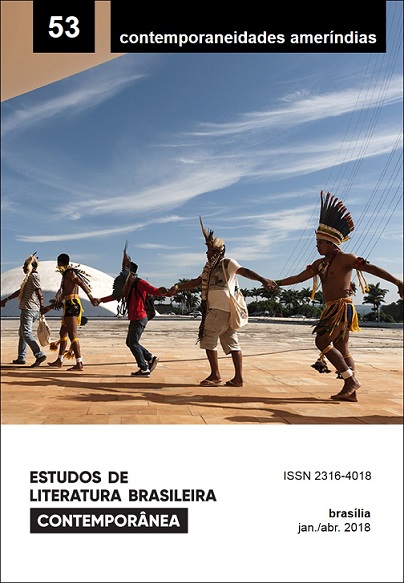Amerindian contemporary:
before the voice and the letter
DOI:
https://doi.org/10.1590/2316-4018531Abstract
Presentation of the dossier about amerindian contemporary.
References
AGAMBEN, Giorgio (2009). O que é o contemporâneo? e outros ensaios. Chapecó: Argos.
AGUIAR e SILVA, Vítor Manuel de (2007). Teoria da literatura. 18. ed. Coimbra: Almedina.
ARISTÓTELES (1986). Poética. Tradução, prefácio, introdução, comentário e apêndices de Eudoro de Sousa. Lisboa: Imprensa Nacional; Casa da Moeda.
AS RAZÕES da Academia Sueca para premiar Bob Dylan com o Nobel de Literatura. BBC Brasil, 13 out. 2016. On-line. Disponível em: <https://goo.gl/eaptMa>. Acesso em: 8 out. 2017.
BARBERENA, Ricardo (2015). Neurofisiologia e literatura brasileira contemporânea: os espaços de ativação das off-cells nas nossas retinas. In: SCHMIDT, Rita Terezinha; MANDAGARÁ, Pedro (Org.). Sustentabilidade: o que pode a literatura? Santa Cruz do Sul: Edunisc. p. 170-179. Disponível em: <https://goo.gl/xcZNmQ>. Acesso em: 8 out. 2017.
CASTRO, Eduardo Viveiros de (2011). A inconstância da alma selvagem. São Paulo: Cosac Naify.
CESARINO, Pedro (2011). Oniska: poética do xamanismo na Amazônia. São Paulo: Perspectiva; Fapesp.
EAGLETON, Terry (1997). Teoria da literatura: uma introdução. Tradução de Waltensir Dutra; Revisão da tradução João Azenha Jr. 3. ed. São Paulo: Martins Fontes.
FARAGE, Nádia (1997). As flores da fala: práticas retóricas entre os Wapishana. 1997. 298 f. 1997. Tese (Doutorado em Letras) ”“ Universidade de São Paulo, São Paulo.
FIOROTTI, Devair Antônio (2012). Do Timbó ao timbó ou o que eu não sei, eu invento. Aletria, Belo Horizonte, v. 22, n. 3, p. 239-252.
FIOROTTI, Devair Antônio (2014). Macunaima e Xicö: deslocamentos semântico-mitológicos na narrativa de Clemente Flores. In: VOLOBUEF, Karin; TRUSEN, Sylvia Maria; SARMENTO-PANTOJA, Tania. (Org.). Tradução, cultura e memória. Rio de Janeiro: 7 Letras. p. 55-68
FRANCHETTO, Bruna (1989). Forma e significado na poética oral Kuikúro. Amérindia, Villejuif, n. 14, p. 81-118. Disponível em: <https://goo.gl/vdftZr>. Acesso em: 8 out. 2017.
GEERTZ, Clifford (2014). A interpretação das culturas. Rio de Janeiro: LTC.
HAVELOCK, Eric (1996). A musa aprende a escrever. Lisboa: Gradiva.
JEKUPÉ, Olívio (2009). Literatura escrita pelos povos indígenas. São Paulo: Scortecci.
LIBRANDI-ROCHA, Marília (2014). A Carta Guarani Kaiowá e o direito a uma literatura com terra e das gentes. Estudos de Literatura Brasileira Contemporânea, Brasília, n. 44, p. 165-191, jul./dez. Disponível em: <https://goo.gl/iQLiLf>. Acesso em: 8 out. 2017.
MUNDURUKU, Daniel (2008). Literatura indígena e o tênue fio entre escrita e oralidade. Overmundo, Lorena, 30 nov. On-line. Disponível em: <https://goo.gl/ifyvYV>. Acesso em: 8 out. 2017.
ONG, Walter J. (2002). Orality and literacy: the technologizing of the word. New York: Routledge.
PEREIRA DE TUGNY, Rosângela (2011). Reverberações entre cantos e corpos na escrita Tikmu’un. Trans: Revista Transcultural de Música, Barcelona, n. 15, p. 1-27.
RISÉRIO, Antonio (1993). Textos e tribos: poéticas extraocidentais nos trópicos brasileiros. Rio de Janeiro: Imago.
ROCHA, Marcos Eduardo (2016). O espaço das literaturas autóctones na crítica literária contemporânea. In: SIMPÓSIO INTERNACIONAL SOBRE LITERATURA BRASILEIRA CONTEMPORÂNEA, 7., Brasília, Universidade de Brasília, 4-7 dez. Pôster. Disponível em: <https://www.gelbc.com/posteresviisimposio>. Acesso em: 14 out. 2017.
SOUZA, Roberto Acízelo de (2011). Uma ideia moderna de literatura: textos seminais para os estudos literários (1688-1922). Chapecó: Argos.
TENNINA, Lucía et al. (2015). Polifonias marginais. Rio de Janeiro: Aeroplano.
WHITEHEAD, Neil L. (2002). Dark shamans: Kanaimà and the poetics of violent death. Duke University Press.
ZUMTHOR, Paul (2001). A letra e a voz: a “literatura” medieval. São Paulo: Companhia das Letras.
ZUMTHOR, Paul (2010). Introdução à poesia oral. Tradução de Jerusa Pires Ferreira, Maria Lúcia Diniz Pochat e Maria Inês de Almeida. Belo Horizonte: Editora UFMG.
ZUMTHOR, Paul (2007). Performance, recepção, leitura. São Paulo: CosacNaify.
Downloads
Published
Issue
Section
License
Authors who publish in this journal agree to the following terms:
a) The authors maintain the copyright and grant the journal the right of first publication, the work being simultaneously licensed under the Creative Commons Attribution License-Non Commercial 4.0 which allows the sharing of the work with acknowledgment of the authorship of the work and publication this journal.
b) Authors are authorized to enter into additional contracts separately, for non-exclusive distribution of the version of the work published in this journal (eg publish in institutional repository or as a book chapter), with authorship recognition and publication in this journal.
c) Authors are allowed and encouraged to publish and distribute their work online (eg in institutional repositories or on their personal page) after the editorial process, as this can generate productive changes, as well as increase the impact and citation of published work (See The Effect of Free Access).
d) The authors of the approved works authorize the magazine to, after publication, transfer its content for reproduction in content crawlers, virtual libraries and the like.
e) The authors assume that the texts submitted to the publication are of their original creation, being fully responsible for their content in the event of possible opposition by third parties.


